Archives
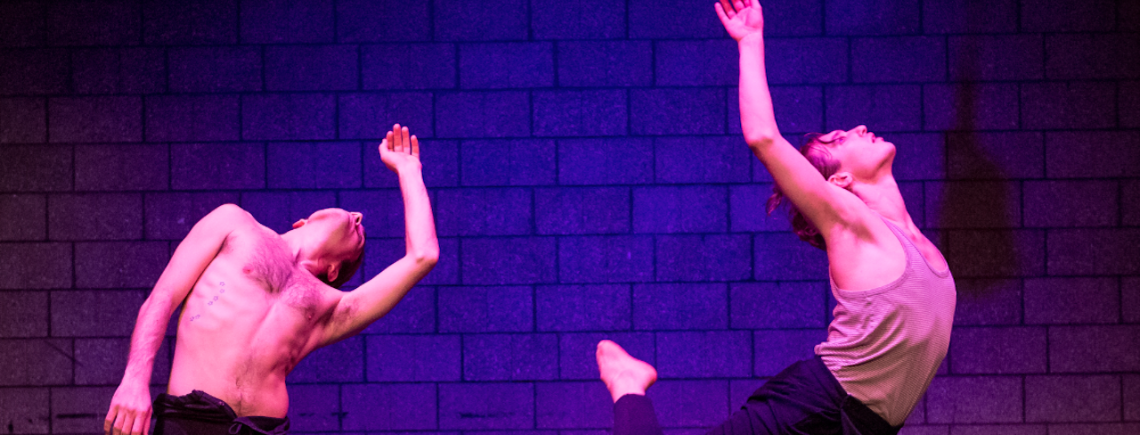
A Predictable Vacuum
A Predicatable Vacuum
by Dean Moss
Published: August 31, 2015 as a part of READING 2015
Originally published in Movement Research Performance Journal #46
1. ASSIGNMENT
Buck Wanner wrote the other day. He said “…we have an idea for an article that we’d like to invite you to address.” He went on to say, “The basic idea would be an article on race…”
Then Buck quoted Ben Pryor, who said:
I think the program has done a pretty bad job of addressing race and I am wondering if there is may- be a way to call attention to this with some sense of sensitivity.
Buck wasn’t sure about Ben’s perception, but was interested in “hearing someone consider it.”
They were looking for a longer article — two to five thousand words — due in February, and offered two hundred dollars.
I felt intrigued, but feigned modesty, accused them of ulterior motives, and suggested they ask someone else.
Dutifully, patiently, and at length Buck reasoned, ending with: “I don’t know what you would say, and I’m curious.”
I don’t know either. Susceptible to flattery or deluded by conscience I agree, and see the work of Tere O’Connor, Jack Ferver, Cynthia Hopkins, Miguel Gutierrez, luciana achugar, Neal Medlyn, My Barbarian, and Jeremy Wade. They all leave varying degrees of good impressions, but these are my colleagues, and this is not a critique of works or artists, but rather an elementary inquiry on realness, race and me.
The festival is… white. Buck and Ben are both white. They’re sincere, honest people, concerned with diversity. So is that why the article they’ve commissioned is being published during Black History Month? I don’t know, coincidence perhaps?
2. DISCLAIMER
South of the Sahara Africans sometimes speak of not knowing they were “black” until they arrived in Europe or America or elsewhere. Sometimes true and always a good line, it’s often met with predictable response from well groomed, inexperienced audiences, titillated by the exotic. I was impressed, though the naming was never an issue. I was black well before I realized I was not white, and was quick to discover the social usefulness of cultivating a being that was also somewhere “not-black”. Because of this, when presented with the choice, I chose to study dance rather than theater. The dance offers a transcendence of identity, whereas theater turns on its recognition.(1) Glib much? Yep, but I really hated performing identity.
Whatever. Trying to be honest, sincere, self-protective. Addressing you, the reader, with the obligatory disclaimer: you know you’re seeing through these eyes, with this gender, this skin, having that experience, paid this much, which leads to predictable conclusions? Maybe. I curated “Black Dance” a couple of years ago. It featured two women and a man: one asian, one white, and one hispanic, no blacks. The white woman appeared in black-face, the asian woman was repeatedly slapped by a white male hand, and the hispanic man ran circles naked, his tongue waggling with a flag of revolution. I thought I was making an obvious statement on perception, until somebody mumbled that what they perceived was a black heart… Funny.
Perhaps it was the not-black heart they perceived. The heart that attempted to escape through cracks in racial convention. The one forced to be adept at immolation and transmutation. My sweet black heart’s much too delicate for that kind of work. The not-black one is battle worn and bulletproof. It’s good to have the two. They make for a tempting blended identity, easily generating a malleable chastened outlook surrounded by the resistive armor of arrogance, like a crusty creme filled brioche. An accident of birth is how they described it at Restaurant Florent, confronting the mystery of why this pensive hetero busboy so well participated in its affluent gay activist life. An accident of birth goes for festivals too, considering the distinction attributed their founders and the necessary nepotism of their beginnings. I thought of those things while trudging repeatedly through Chinese and Jewish neighborhoods and arriving to be guided by Abron’s black and hispanic staff, joining vastly white audiences for vastly white shows, knowing I too (black, not-black, not white, not gay) had been invited to share that stage.
3. BACKGROUND
Eric Torres introduces an interview:(2)
To many LGBT-identifying people, the word ‘realness’ evokes a very specific image in queer history. It’s the sequence in Jennie Livingston’s 1990 documentary Paris Is Burning, in which several late 80’s NYC queens display what ‘realness’ truly means: to blend seamlessly into heterosexual culture despite your queerness….
Then asks:
How do you define ‘realness’ in relation to the arts?
Ben rejoins:
With the festival, I consider Realness in relationship to the performativity of personhood and identity and how these ideas are played with in the performance of life, highlighted here for us on stage…
He goes on to say:
There is also a level of “realness” that relates to the underfunded nature of American work (dance/theater/ performance) in relationship to international work. It is about acknowledging that there is more frequently a DIY, raw aesthetic employed in this American work versus its international counterparts…
And finishes with with a flourish:
There is also the level of marketplace… So American Realness is also about selling your goods. In the traditional American entrepreneurial spirit, we have set up shop and we are for sale.
So let’s tease this out. Performativity of personhood, DIY aesthetic, and the entrepreneurial spirit, American Realness indeed. Exciting stuff, but what the interview really made me want to do is see the film again. I sensed a void. Surely something else was part of the realness of the documentary, something that seems completely missing from the interview. Of course it doesn’t take firing up Netflix and watching for seventy-eight minutes to know the answer to that: race. Race in America. Race as exotic other. Race as proxy for Marxist class critique. How can they not mention it? The concept of realness itself comes from the specificity of that late century urban circumstance and the people who lived it. The film takes place in Harlem, the lives depicted are black and hispanic, the aspirations are of the poor and disenfranchised, their overwhelming desire to hold for however fleeting a moment the image of the financial security and social mobility found exclusively in the glamorized majority population: to model the trappings of whiteness. What’s amazing and heartbreaking in the film, is a minority community’s transmutation of hegemonic paradigms of control, into an exercise in support of its own identity. This was made all the clearer in the film, because that community was of a different color than the near invisible ruling class, and the act of “passing” was in a singular direction: from marked to unmarked. Realness here, is a qualitative assessment of how well one passes into invisibility: into an imagined, all-inclusive, fiscally affluent reality.
My college anthropology course reminds me: The capacity for a culture to become dominant resides in its superior ability to assimilate or marginalize the other. Meaning, in more brutal terms: whites victoriously absorbed what they could and destroyed the rest, but because their dominance was considered the norm, they were culturally near invisible (even to themselves) while doing it.
But not for George Yancy’s prying eyes, who asks:(3)
Do you also see whiteness as ‘a stylized repetition of acts’ that solidifies and privileges white bodies…?
Judith Butler counters:
Yes, we can certainly talk about ‘doing whiteness’ as a way of putting racial categories into action, since whiteness is part of what we call ‘race,’ and is often implicitly or explicitly part of a race project that seeks to achieve and maintain dominance for white people. One way this happens is by establishing whiteness as the norm for the human…one that is built up over time, through daily practices, modes of address, through the organization of schools, work, prison, law and media… all ways that the conceit of white superiority is constructed.
I’ll be eleven years from my one hundredth birthday or dead when white demographic superiority finally disappears in the United States. Long before that, the projection of them as normality will have passed. Already their status as default human beings and the attending invisibility are gone. Whites are white. Economically a more powerful racial niche than all the rest, but a stylistically recognizable niche none the less. And yet in some corners the concept of an invisible white norm lingers, particularly in contemporary arts. Is this why Eric and Ben didn’t mention race in their descriptions? I don’t know, coincidence perhaps?
4. RESPONSE
AR 2015 was hugely successful! Twenty-six artists featured in seventy-seven events over fourteen days, and it sold out from beginning to end. If the goal was to attract international presenters, local arts professionals, queer and contemporary artist communities, along with a smattering of the general public, they’ve more than effectively mobilized their target audiences. As for entrepreneurial spirit, over the last five years American Realness has grown from niche player to become arguably the most dominate force in the contemporary dance scene of the Association of Performing Arts Presenter’s yearly New York City conference. I literally heard a choreographer complain AR had sucked the air out of all other contemporary dance showcases. An exaggeration to be sure, but by all accounts they’re killing it, and perhaps therein lies the crux.
It seems damning when the neighborhood, the theater staff, and even the vastly white audiences, are more racially diverse than the artists and performers on stage. It seems damning when that same disparity is reflected in the technical staff, the festival marketing, the theater’s upper management, and of course ubiquitously among funders and presenters. It seems damning even if realistically unaddressable, because to challenge normality is the festival’s raison d’étre. This amazingly successful festival, through its name, draws and profits from a legacy. That legacy in turn places upon the festival a responsibility. That responsibility is to be within its specificity inclusive: somewhere there’s a place for us… this is that place.
That it should appear to break so drastically along color lines points to the past, to the historical effects of a segregated society, and to a resonance with the purveyors of control, as opposed to those who subvert it. The practicalities of curating inclusively for such a distinct circumstance are not trivial, and I enthusiastically applaud Ben for his brilliance, his foresight, his ongoing accomplishment, still I have to agree with his own assessment of the program in regards to non-white racial involvement. It seems, as the festival has grown, it has not brought a deeper investment in diversity. This year was particularly bleak with not a single visibly non- white choreographer’s work presented.(4) Though I know first hand some were asked, still the impact of programming is determined by what’s delivered. Does this mean the festival’s curatorial peculiarity was an anomaly? Perhaps, but looking at the lineup over the last several years, I would suggest that the curation was too reliant for diversity on the same few artists, and when they weren’t available, there became a predictable vacuum.
Last year it was striking to see the appearance of someone new tackling a rigorous, intricately layered, character driven, exploration of black racial experience. Her performance spoke to me through its surprising and careful articulation of very specific tropes. Not everyone appreciated the work as I did. But everyone must want to share the possibility of that kind of deep experience. An experience based not in race, but in recognition. Finding the self in an unknown other through art is subversive and contradictory. It involves passing one thing off as another. It involves a lot of moving parts bound together so tightly that if one goes missing, there’s a vacuum. American Realness is my place to escape the vacuum. When it doesn’t deliver, I feel that much less.
5. QUESTIONS
So what are the requirements for realness now, when the leader of the free world is a mixed race black, and the CEO of its richest publicly traded corporation is openly gay? (Unimaginable thirty years ago in Harlem, or anywhere else.) How can today’s minority queer community transmute the infinitely more subtle paradigms of control into an exercise in support of its own identity? How does that exercise manifest visibly in the festival when the outward characteristics of the community, and those of the ruling class are essentially the same? What now is the role of passing, what are its directions, its goals? How do we keep American Realness from becoming quaint, nostalgic, irrelevant and passing into invisibility?
Seems natural, given these and like questions swirling around in more than my own mind, that the artists’ works I saw this year all dealt very specifically with duality. Whether it was the self literally split into on-stage characters, or the auto- biographical rant to an audience also perceptually the self, or the self dissolved into participatory environments, it was a fascinating parade of artists looking into the the looking glass. Their meta-mirroring reminded me of the Ancients’ two-faced Janus. The god of beginnings and transitions, who looked simultaneously to the future and the past, over exchanges both internal and external. It made me think that the artist’s strategy of self-fragmentation, combined with the act of moving between the various selves, was an effective means of evoking, and thereby marking, the myriad invisibles that divide and bind us.
However to assure a similar efficacy, for a festival at the curatorial level, it would need to consistently explore the broadest possible sense of self, articulated by the widest possible diversity of participants in the deepest possible manner. The survival of the festival would depend on it. At the end of the film Paris Is Burning, a golden elder queen speaks to the mellowing of ambition over time, appreciating the accomplishments of survival, but also says: “…everyone wants to leave something behind them, an impression, a mark upon the world…”. For American Realness I can imagine nothing less.
This article originally submitted February 4, 2015.
(1) Anonymous
(2) Gayletter: Ben Pryor On American Realness By Eric Torres, published January 2014
(4) By “visibly non-white” I mean obviously ethnic; that racial diversity need be obvious to my eye, which by dint of experience is finely calibrated. Conceivably two works were presented in the festival by ethnically “other” makers, however those makers “read” visually within the broad range of white.
READING is made possible with support from The Andrew W. Mellon Foundation.
image: Ian Douglas
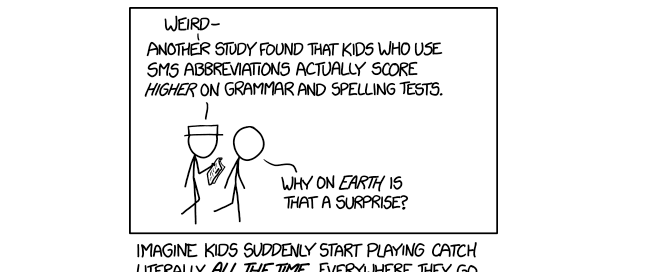
Reading Skills
Reading Skills
by Buck Wanner
Published on: August 31, 2015 as a part of READING 2015
“Writing Skills,” http://xkcd.com/1414/
I have so many things to say about editing. Except when I go to actually say them, what I’m actually doing is writing, and when it comes to writing, I have a lot of hesitancy. This hesitancy comes, annoyingly, from being an editor. How accurate are the perspectives I want to put forth? What will be the impact from me saying them? Do I actually believe what I’m about to write?
These questions and others nag at me when I sit down to write anything, because after roughly five years of being an editor, I compulsively ask these questions of every piece of writing I engage with. What is clear to me, and worth making explicit, is that writing something is not neutral, and never has no impact. While this may be obvious, or at least easy to accept, the fact that writing has an impact on the world leads to several corrollary implications that are central to what I consider to be my job as an editor. The questions I posed above, regarding how I think about my own writing, actually developed from working on texts in-process, and trying to find what was necessary to consider in developing pieces of writing.
In introducing Summer READING, I feel compelled to say something about how I go about editing, because the timing for releasing the essays collected here may, upon reading, seem a little confusing. Several of the pieces were authored in January and February (others later), and at least one explicitly imagined itself being read during the month of February (see Dean Moss’s contribution). The delays were mostly organizational — a lack of time and resources resulting in a feeling that the proper context for these writings couldn’t be delivered on the originally intended timeline. For me, it didn’t make sense to simply release a handful of essays into the Wild Wild Web without situating them somehow. Writing — amazingly, somehow — affects what people think, influences what they talk about, and impacts how things are perceived and understood. I hate hyperbole (hah), and I don’t want to suggest that what people write about performance is more important than what people actually do when performing, but the significance of the written word, particularly with the texting generation, is lost on no one (see opening comic). Though text can sometimes feel transient because of how ubiquitous it is, the only reason anyone would ask me to do what I do is some notion that producing text around performance does, actually, matter.
I think there is a particular importantance when writing on performance to address the ethics of accuracy, precisely because of the very different natures of “writing” and “performance” regarding rates of diffusion and authority of representation. The written word holds power over live performance because it often will represent the performance sooner, more broadly, and for a longer duration than the performance itself can ever hope to. The performance work our community engages in often consciously works against this fact, but it can’t entirely escape it.
Taking responsibility for these aspects of writing is a significant aspect of my job as an editor. In order to facilitate useful writing on performance, I have to be familiar with the field I’m working with. I have to have an idea of what discussions are current in the community, who is actively involved in these discussions, or alternatively, who has a unique perpsective. I have to be familiar with artists’s work, as well as the work of people who could write about artists (not necessarily distinct people). These are in some sense prerequisites, but I think are pretty important to doing this work, because without a background, and without staying current, I can’t have a good sense of the purpose of the writing or a sense that whatever is written fairly represents its topic. This isn’t merely fact-checking, but again having a sense that a perspective in writing can (and hopefully will) impact how people relate to the performance, and not taking that impact lightly.
One way to illustrate what an editor does is to look at situations where the editorial function failed to perform. This past year, the major controversy surrounding the (since retracted) Rolling Stone article, “A Rape on Campus,” resulted in a case study of the need for rigorous editorial protocols. In an example closer to home, I would note Culturebot’s excellent coverage of the Dance/USA article “Is American Modern Dance a Pyramid Scheme?”. While the Dance/USA article received numerous responses regarding the author’s faulty logic and poorly-informed perspective, an ethical question regarding the article’s opening anecdote also arose:
In the days after the article’s release, a different set of issues came forward. This concerned current Assistant Professor of Dance at Loyola Marymount University, Rosalynde (Roz) LeBlanc, whose personal story and photo were used to frame Austin’s argument…. Unfortunately, Ms. LeBlanc was never contacted about the use of her personal story and photo for the article…. The original article framed LeBlanc’s story in a way that implied her endorsement of the author’s views.
You can read the Culturebot article for a further discussion, but what I find this episode highlights is the significance of accuracy, both regarding facts as well as in presenting the writer’s individual perspective. A writer can present any perspective they want, but they need to present the facts and reporting they used to support their perspective accurately. A publisher can present any writer or article, but in doing so, they vouch for the article’s accuracy and the writer’s qualifications to present their perspective.
Dance/USA eventually edited the article to remove the misleading reference to LeBlanc. In the editorial note acknowledging the change, Dance/USA concluded with, “The opinions and views expressed in this article are the author’s and do not reflect the opinions and views of Dance/USA.” This is something basically every publisher in every media says about their content always, and it’s a total cop-out: publisher’s names and reputations are very much determined by the content they deliver, and they likewise lend that reputation to what they produce. If this author had put the article on their personal blog, no one would have noticed nor cared. The difference lies in the visibility provided by the publishing platform, and the implicit authority designated by the organization.
READING has been a collection of writings related to the performance work in the festival American Realness, published by AR. I don’t believe impartiality is possible (or even desirable) in most situations regarding writing on performance — how could someone be dedicated enough to performance to become deeply informed about it, yet still aim to be “impartial”? — but clearly, with READING there is an agenda that is unhesitatingly concerned with supporting the work of the artists in the festival. I bring these points forward, not because they aren’t already obvious, but to make explicit that the editorial perspective here already assumes this work is worth engaging with, and seeks to give readers more entrypoints for that engagement. These entrypoints are not always concerned with analyzing specific works, though it may also mean having several people address the same work(s) in different ways.
So the collection at hand: Summer READING. In past years, READING has been released during the festival itself, to provide context and perspectives to the performances people were seeing, as they were seeing them. The concept for this year was different from the beginning — it was never the plan to release during the festival — though we still thought it would come out with the festival fresh in peoples memories. Our significant delay required some repositioning, in order to be fair to the writers as well as the topics they address. With characteristic branding brillance, Ben Pryor proposed we title this edition Summer READING. I like the title, and think it works to situate the collection and how we might approach it. “Summer reading” suggests a relaxed but attentive mood; it’s something you’ve been putting off, but are excited to finally get around to. The distance of the subjects in the essays may create a lack of obvious immediacy, but this can also allow for a more reflective and even-tempered consideration of the works. What remains significant when the things we are talking about didn’t just happen? What still lingers and hangs around? How do the authors’s perspectives, written close to the events they describe, resonate half a year later?
READING is made possible with support from The Andrew W. Mellon Foundation.
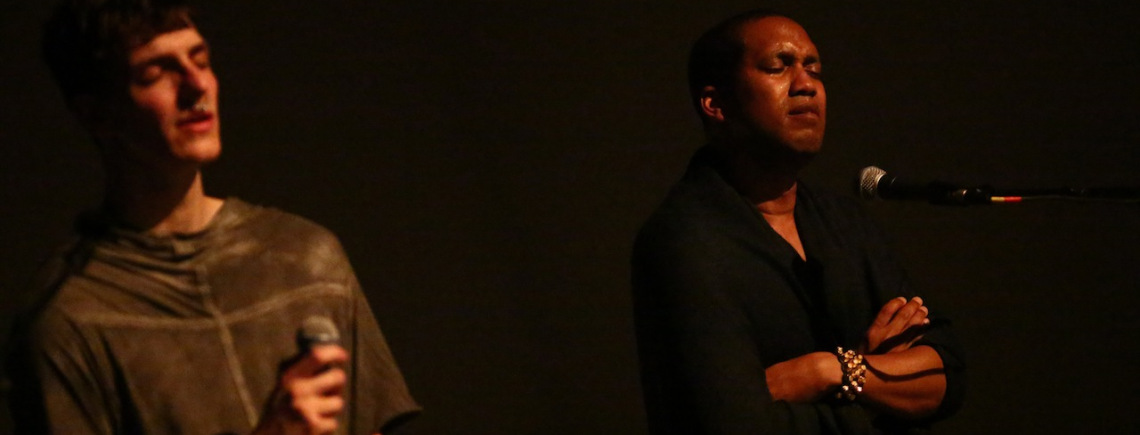
Trajal Harrell
Antigone Jr. ++/ Twenty Looks or Paris is Burning at the Judson Church (Plus)
SUN JAN 11, 1:00 PM + 7:00 PM
Run time: 50 minutes
RONALD FELDMAN GALLERY
31 Mercer Street / FREE / RSVP: AmericanRealness@gmail.com
Antigone Jr. Plus Plus is the PLUS size in Harrell’s acclaimed Twenty Looks or Paris is Burning at the Judson Church series. In American and English naming tradition, a junior (jr.) is the son of a father with the same name. Thus, with Antigone jr., the New York choreographer Trajal Harrell purposely scales down Sophocles’ tragedy to playwright’s first scene depicting the relationship between Antigone and her sister Ismene; and their tragic fate.
Antigone Jr. confronts the postmodern antagonism against tragically dramatic dance epitomized by Martha Graham’s mythological Greek dramas by presenting this contemporary dance version of Sophocles’ “Antigone”. By imagining a theoretical meeting between Voguing and Post-modern dance, much of Yvonne Rainer’s 1965 “No Manifesto” is put into crisis. Most of the no’s become definite maybe’s: maybe to spectacle, maybe to transformations and magic and make-believe, maybe to the glamour and the transcendency of the star image, maybe to the heroic, maybe to involvement of performer or spectator, maybe to style, maybe to trash imagery, maybe to camp, maybe to seduction of the spectator by the wiles of the performer, and maybe to moving or be moved. The only thing we know for sure is yes to the heroic and we’re adding yes to the tragic.
Here we have Antigone Jr “plus” a surprise additional fifteen-minute epilogue.
Trajal Harrell’s work has been presented In New York and the U.S. at many venues including Crossing the Line Festival, The Kitchen, New York Live Arts, TBA Festival- Portland, Walker Arts Center-Minneapolis, American Realness Festival, ICA Boston, Danspace Project, DTW, P.S. 122, Cornell University, Colorado College, Philadelphia Live Arts and Los Angeles’ RedCat Theater. His work has been presented internationally at festivals such as Festival d’Automne (Paris), Rencontres Chorégraphiques (Paris), Festival d’Avignon, Impulstanz (Vienna), TanzimAugust (Berlin), Panorama Festival (Rio de Janeiro), Festival Transmeriques (Montreal), and Holland Festival, among others. He has also shown performance work in visual art contexts such as MoMA, MoMA PS1, Performa Biennial, Fondation Cartier (Paris), The New Museum (NYC), The Margulies Art Warehouse (Miami), The Bronx Museum of the Arts, Serralves Museum (Porto), Centre Pompidou- Metz, Centre Pompidou-Paris, ICA Boston and Art Basel-Miami Beach. He has been a receipient of fellowships from The Saison Foundation, The Guggenheim Foundation, Art Matters Foundation, Foundation for Contemporary Arts, and the Doris Duke Foundation. He is perhaps best known for a series of works entitled Twenty Looks or Paris is Burning at The Judson Church which re-imagine a meeting between early postmodern dance and the voguing dance tradition and created in seven sizes. Antigone Sr., the large in the series, won the 2012 Bessie
Award for Best Production. He is currently involved in a two-year Annenberg Research Commission Residency at The Museum of Modern Art- MoMA.
Trajal Harrell’s work has been presented In New York and the U.S. at many venues including Crossing the Line Festival, The Kitchen, New York Live Arts, TBA Festival- Portland, Walker Arts Center-Minneapolis, American Realness Festival, ICA Boston, Danspace Project, DTW, P.S. 122, Cornell University, Colorado College, Philadelphia Live Arts and Los Angeles’ RedCat Theater. His work has been presented internationally at festivals such as Festival d’Automne (Paris), Rencontres Chorégraphiques (Paris), Festival d’Avignon, Impulstanz (Vienna), TanzimAugust (Berlin), Panorama Festival (Rio de Janeiro), Festival Transmeriques (Montreal), and Holland Festival, among others. He has also shown performance work in visual art contexts such as MoMA, MoMA PS1, Performa Biennial, Fondation Cartier (Paris), The New Museum (NYC), The Margulies Art Warehouse (Miami), The Bronx Museum of the Arts, Serralves Museum (Porto), Centre Pompidou- Metz, Centre Pompidou-Paris, ICA Boston and Art Basel-Miami Beach. He has been a receipient of fellowships from The Saison Foundation, The Guggenheim Foundation, Art Matters Foundation, Foundation for Contemporary Arts, and the Doris Duke Foundation. He is perhaps best known for a series of works entitled Twenty Looks or Paris is Burning at The Judson Church which re-imagine a meeting between early postmodern dance and the voguing dance tradition and created in seven sizes. Antigone Sr., the large in the series, won the 2012 Bessie
Award for Best Production. He is currently involved in a two-year Annenberg Research Commission Residency at The Museum of Modern Art- MoMA.
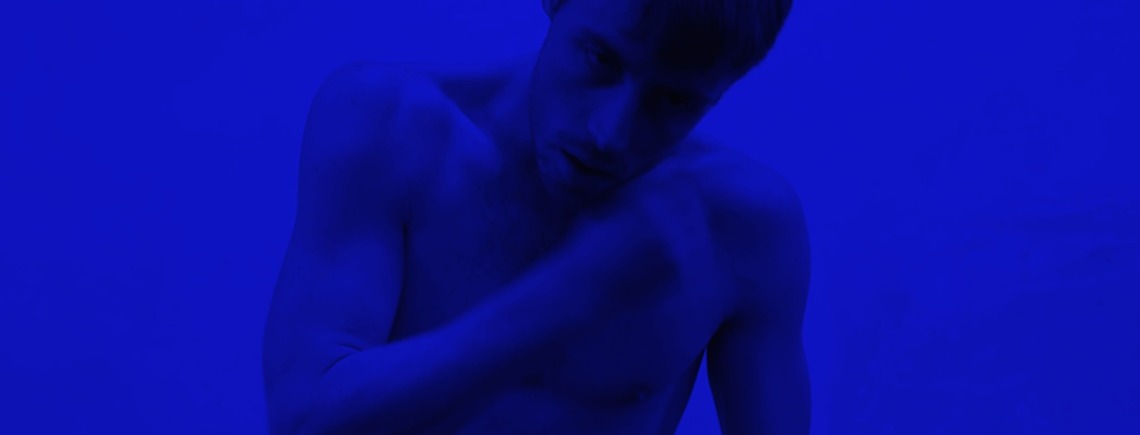
Anne Imhof
DEAL, 2015
Presented by MoMA PS1
World Premiere
SAT JAN 17, 2:00 PM
SUN JAN 18, 2:00 PM
Run time: 4 hours
MoMA PS1
22-25 Jackson Avenue / FREE with museum admission
In her inaugural US solo project Anne Imhof works with a group of performers, composers, lawyers, and a family of white rabbits. Incorporating sequences of the artist’s earlier works, SCHOOL OF THE SEVEN BELLS (2013) and RAGE (2014), DEAL, 2015 unfolds over the course of two days and in two different locations simultaneously.Through continuous reintroductions of structural motifs in space the work focuses on relations of coded transactions between participants. The result is an image gradually emerging in time. With: Franziska Aigner, Billy Bultheel, Frances Chiaverini, Ian Edmonds, Mickey Mahar, Olga Pedan and Lea Welsch.
Anne Imhof, DEAL, 2015 is a MoMA PS1 Commission as part of Sunday Sessions.
With special thanks to Goethe-Institut.
Sunday Sessions is organized by Jenny Schlenzka, Associate Curator with Alex Sloane,Curatorial Assistant and Rosey Selig-Addiss, Associate Producer.
Sunday Sessions and the VW Dome at MoMA PS1 are made possible by a partnership with Volkswagen of America.
Major support is provided by MoMA’s Wallis Annenberg Fund for Innovation in Contemporary Art through the Annenberg Foundation.
Photo by: Nadine Fraczkowski


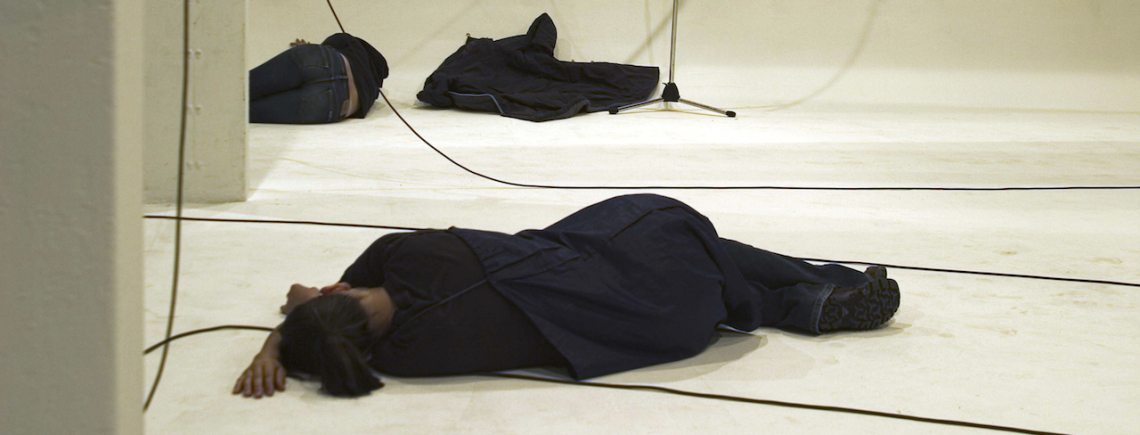
Why Choreography Now?
Reading, Conversation, Performance of The Choreographic
SAT JAN 17, 1:00 PM
ABRONS ARTS CENTER, PLAYHOUSE
466 Grand Street / FREE
Why Choreography Now? celebrates the launch of The Choreographic by Jenn Joy. Please join us for a reading, conversation with the Hilary Clark, DD Dorvillier, Miguel Gutierrez, Heather Kravas, remarks by Kelly Kivland, projections by James Foster, a surprise performance and a toast to all the artists!
Written in intimate conversation with experimental works in contemporary dance, visual art, and theory, The Choreographic considers what choreography—as practice, as concept—offers to this particular moment of cultural crisis marked by deluges distinctly political and climatic. To engage choreographically is to position oneself in relation to another, to participate in a scene of address that anticipates and requires a precarious mode of attention, even at times against our will. Trespassing across corporeal and cerebral conjecture—from tremulous laughter, to ecstatic spasm, to stuttering stillness—the choreographic works against linguistic signification and virtuosic representation; it is a labor of contact that touches even across distance.
DD Dorvillier, No Change, or, “freedom is a psycho-kinetic skill,” 2004. Photo by Eileen Travell
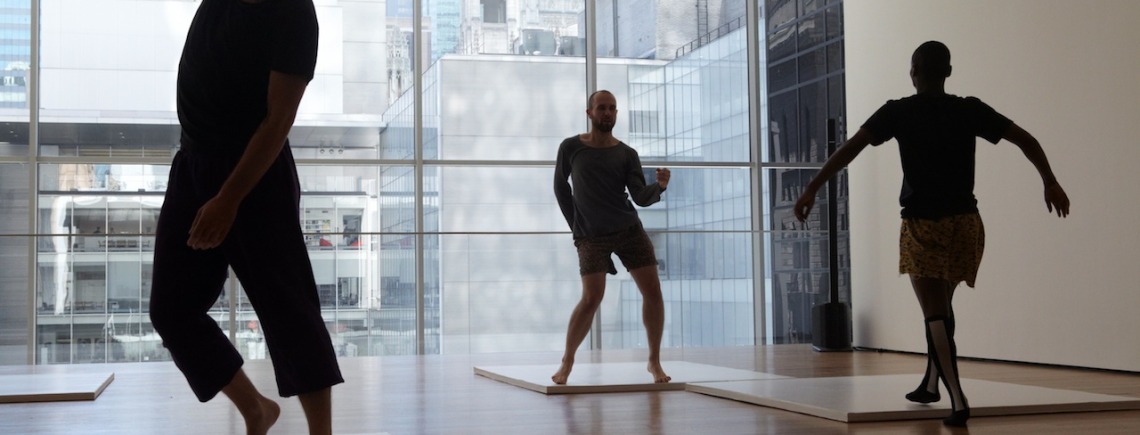
Trajal Harrell, Eiko Otake and Sam Miller
Trajal Harrell, Eiko Otake, and Sam Miller in Conversation
Presented by The Museum of Modern Art
THURS JAN 15, 7:00 PM
MUSEUM OF MODERN ART, THE ROY AND NIUTA TITUS THEATER 2, T2
11 W 53rd St / $12 adult, $10 senior, $8 student, $5 member guest, free for members / MoMA.org
In one step are a thousand animals is the title Trajal Harrell (American, b. 1973) has given his two-year Annenberg Research Commission Residency project. One of the most prominent choreographers and dancers of his generation, Harrell confronts the history, construction, and interpretation of modern, post-modern and contemporary dance.
In one step are a thousand animals includes an in-depth exploration of the history of butoh, a Japanese dance form created in part to resist the conservatism permeating postwar choreography, and the life and work of Japanese choreographer Tatsumi Hijikata (1928–86), a butoh pioneer. It includes a series of performances and discursive events, including the creation of a new piece for 2016. Through the prism of butoh, Harrell will also focus on the conditions of the museum space and what dance in museums can make visible that other combinations of media, processes, and spaces cannot. The project began in September 2014 with The Practice, in which Harrell offered insights into his working method, inviting participation from renowned musicians, stylist, singers, and dancers.
For this second iteration, Harrell engages in a conversation with Eiko Otake, Japanese choreographer and dancer, who works primarily with her partner Koma. Both Eiko and Koma have studied with Kazu Ohno and Hijikata, and moved to New York in the 70s, developing their own choreographic practice. Trajal Harrell and Eiko & Koma were part of the performance series Performing Histories: Live Artworks Examining the Past, in connection with the exhibition Tokyo: The New Avant-Garde 1945–1970 at MoMA in 2012. Eiko & Koma participated with their The Caravan Project, while Trajal Harrell presented the performance Used Abused and Hung Out to Dry, his first investigation of Hijikata’s work and the aesthetic possibilities of butoh. Together with Sam Miller, the President of the Lower Manhattan Cultural Council, the two artists, in their first public conversation, will talk about the artistic legacy of avant-garde dance forms in 1960s Tokyo, Eiko’s integral participation in that scene, Harrell’s research on butoh, and the parallel aesthetic threads in their work.
Organized by Ana Janevski, Associate Curator, with Martha Joseph, Curatorial Assistant, Department of Media and Performance Art.
The project is made possible by MoMA’s Wallis Annenberg Fund for Innovation in Contemporary Art through the Annenberg Foundation.
Photo: Trajal Harrell. The Practice. 2014. Photograph © 2014 The Museum of Modern Art, New York. by Julieta Cervantes
![]()
INDUSTRY TICKETS
SIGN HER UP!
American Realness is pleased to invite national and international performing arts presenters and funders to register for discounted tickets to festival performances. Professional Registration for 2018 has not yet been released. It will happen ASAP. Contact Debbie Huang at AmericanRealness(@)gmail(.)com for more details.
SUPPORT AR
Become a member of the House of Realness!
Since 2010, American Realness has presented adventurous new dance and performance at the Abrons Arts Center and venues around the city for the annual Association of Performing Arts Presenters’ conference. The program has been instrumental in helping participating artists generate over one million dollars of new revenue from national and international performance engagements. Additionally the program has been recognized as “a nexus of smart, cutting-edge performance” by The New York Times, was cited in ArtForum’s Best of Dance 2010.
BUT HONEY, LETS GET REAL…
While the program receives unparalleled administrative, marketing and other in-kind support from Abrons Arts Center and has received generous support from The Andrew W. Mellon Foundation, we depend on the help of our donors to make this event the spectacular convening of artists and audiences that it is. I invite you to become a member of the House of Realness and help change the game for this game-changing program.
A donation of any size grants you membership to the House of Realness. All donors are invited to the Opening Night Toast to kick off the festival at 5pm on Thursday January 5th at Abrons Arts Center. Donors of $100 or more can recieve reserved seats for any festival performances they attend (tickets sold separately). Donations are fully tax-deductible when made through Gibney Dance.
BECOME A MEMBER OF THE HOUSE OF REALNESS TODAY!!
I hope you will join me and become a member of House of Realness.
I sincerely thank you for your support and I look forward to seeing you at performances!
Much love,
Ben Pryor
Curator and Producer
American Realness
THANK YOU TO ALL THE MEMBERS OF THE HOUSE OF REALNESS!
Founding Mothers of the House of Realness
Abrons Arts Center, The Andrew W. Mellon Foundation
Guardian Hairdressers of the House of Realness
The Mertz Gilmore Foundation
Legendary Members of the House of Realness
Anne Delaney, Robert M. Pryor, Shannon Snapp
Grand’ma Mothers of the House of Realness
Rio Rutzinger
Mothers of the House of Realness
Lisa Branch, meredith l boggia, Lucien Zayan
Non-Patriarchal Fathers of the House of Realness
Vallejo Gantner, Joanna Klass, Samuel Miller
Aunties of the House of Realness
Kyle Abraham, Charles Atlas, Ron Berry, Dr Dara Blumenthal, Suzanne Bocanegra & David Lang, Jim Bott, Jeffrey N. Bullock, Chris Cochrane, Sara Coffey & Dave Snyder, Angelo DeSanto, Marc Eagle, Cathy Edwards, Mz. Gacy, Neil Greenberg, Tarek Halaby, Caleb Hammons, Theodore Henigson, David Herskovits, jenn joy, Ellina Kevorkian, jenny lacey, Marilyn, Laura McDermott, Jeffrey Moon, Tere O’Connor, Shayna O’Neill, Stephen Palgon, David Parker, Hillary Pryor, Shannon Pryor, Mark Russell, Margaret Sheriff, Martha Sherman, Lauren Slone, Linda Stein, Marc Streit, Ivan Sygoda, Trajal, Gwen Welliver, Adrienne Willis, Diane Wondisford
Gender Neutral Pronoun of the House of Realness
ArKtype / Thomas O. Kriegsmann, Rob Avila, Eleanor Bauer, Megan Z Brian, Alison Bory, Jennifer Calienes, Geraldine Celli, Michael DiPietro, Lenore Doxsee, Elizabeth R. English, Moriah Evans, Matthieu Goeury, Sondra Graff, Maria Hassabi, John Jasperse, Mark Jeffery, Marisa König Beatty, Marjana Krajac, Sandrine Kuster, Gideon Lester, Seán Linehan, meg, Meiyin, Roarke Menzies // Acousmatic Arts, Hope Mohr, Franco Pedicini, Julie Phelps, People Get Ready, Kathe Robin, Alexandra Rosenberg, Kerry Scheidt, Ellen Schneiderman, Scott, Todd Shalom, Michael Sheriff, Yoko Shioya, James Turnbull, aynsley vandenbroucke, Renee Wadleigh, Jonathan Walker, charlie welch
Brothers & Sisters of the House of Realness
luciana achugar, John Andress, Aliza Arenson, David Bernstein, Sarah Bishop-Stone, Megan Byrne, Peggy H. Cheng, Ellen Chenoweth, Hilary Clark, Abby Crain, Jeanine Durning, Jack Ferver, Robert Flynt, Alley Frey, Jesse Geiger, Brighid Greene, Luke George, I AM A BOYS CHOIR, Irfana Jetha Noorani, Juliana, Stefanie Karlin, Amy Khoshbin, Kyli Kleven, Jaamil Kosoko, Alexandra Madera, Juliana May, yvonne meier, LUKE PELL, Jillian Peña, Carla Peterson, Alexandra Pinel, Pique, Ramzi, Angela Romualdez, Laura Stillwagon, John Scott, Eric Shethar, Marci Skolnick, Michèle Steinwald, Judy Hussie-Taylor & Steven Taylor, Larissa Velez-Jackson, Katie Vickers
Children of the House of Realness
Julie Alexander, Roya Amirsoleymani, Laura Arrington, Simone Aughterlony, Lydia Bell, Madeline Bell, Olive Bieringa, Dan Bittner, Becca Blackwell, Lily Bo, Michelle Boulé, Chase Brock, Jibz Cameron, Carol, Daniel Clifton, Simon Courchel, Sara Crawford Nash, Clare Croft, Sarah Curran, Liliana Dirks-Goodman, Christophe Doloire, Talya Epstein, Elizabeth Feidelson, Jordan Fein, Jaime Fennelly, Jacob Gallagher-Ross, Brandon Gross, Miguel Gutierrez, Andrea Haenggi, Amanda Hamp, Robert Hart, Ron Helpman, K.J. Holmes, Isabella Hreljanovic, Andrea Kleine, Josh L., Kristine Haruna Lee, Michael Levinton/Little Lord, Melanie, Jessica Massart, dana michel, Daisy Phillips, Jody Oberfelder Dance Projects, Jumatatu Poe, rachel, Risa, Matthew Rodrigues, Hahn Rowe, Abi Sebaly, lucy sexton, Yuval Sharon, Aaron Shackelford, Samantha Sheppard, Steven Skerritt-Davis, RoseAnne Spradlin, Laura von Holt, Nicolle Wasserman, Rebecca Wender & Ian Douglas, Emily Wexler, Moe Yousuf
Friends of the House of Realness
Alex, Alexandra Albrecht, Tyler Ashley, Julian Barnett, Laurie Berg, Jonathan Bigelow, Anna Brady Marcus, Tony Carlson, Francis Christeller, Marc Crousillat, Earl Dax, Tess Dworman, Christine Elmo, Sharon F., James Franco, Ben Gansky, Meredith Glisson, Michael Goldberg, Jesse Hewit, John Hoobyar, Mary E I Jones, Kirstin Kapustik, Benjamin Kimitch, Joanna Kotze, Anna Kroll, Andy Kuncl, Eric Larson, Daniel Linehan & Michael Helland, Victoria Lynford, mickey mahar, Carly McC, Neal Medlyn, niallllain, Lydia O, Breanna O’Mara, Laura Pattillo, Jess Reed, Alex Rodabaugh, Erik Rogers, laura s.romero, Tara Sheena, Deena Spaner, Carrie Stern, Noelle Stiles, Franklin D. Swann, Kathleen Telfer, Tatyana Tenenbaum, adrienne truscott, Robert Tyree, Rebecca Warner, Jaime Wright
Fangurls of the House of Realness
8X10 House, Pedro Arieta, Matthew Herbertz, Johnson Hor, Luna Paese, Katherine Pan, Annie Tippe, Rebecca Warzer
FESTIVAL PASS
I WANNA SEE IT ALL!
American Realness 2018 offers two festival pass options. Both get you 5 shows for $100, offering a $5 discount on single ticket prices! It’s like buy 4 get one free! Indulge and get one of each.
ABRONS FESTIVAL PASS: SELECT 5 FOR $100
nora chipaumire, #PUNK
NIC Kay, lil BLK
Jaamil Olawale Kosoko, Séancers
Neal Medlyn, I <3 PINA
Marissa Perel, (do not) despair solo
jumatatu m. poe and Donte Beachem, Let ‘im Move You: A Study (2013/2016) and Let ‘im Move You: This Is a Success (2016)
Michael Portnoy, Relational Stalinism – The Musical
Rosy Simas, We Wait In The Darkness
Adrienne Truscott, THIS
Mariana Valencia, ALBUM
GIBNEY fESTIVAL PASS: SELECT $5 FOR $100
Simone Aughterlony & Jen Rosenblit with Miguel Gutierrez and Colin Self, Everything Fits In The Room
Claire Cunningham & Jess Curtis, The Way You Look (at me) Tonight
Michelle Ellsworth, The Rehearsal Artist
Moriah Evans, Figuring
keyon gaskin, [a swatch of lavender]: a self portrait
Antonija Livingstone & Nadia Lauro, les études (heresies 1-7)
VOLUNTEER
HELP OUT AT AMERICAN REALNESS
Volunteers are an essential part of the American Realness team helping us realize the festival to the greatest potential. In recognition for your time, we offer you a FREE ticket to an American Realness performance at Abrons Arts Centre for every shift that you complete. Becoming an American Realness volunteer offers you an opportunity to gain intimate access into the festivals working, the festival staff and artists contributing to the festival.
American Realness runs from January 9th through the 16th, 2018 at Abrons Arts Center, Gibney Dance, The Invisible Dog Art Center, SculptureCenter, Participant Inc. and more. As a Volunteer with the festival there are several different shifts that are offered. These include:
Theater Preparation:
Each volunteer shift begins ONE HOUR before the performance you are assisting. For a 7PM performance you will report to the theater by 6PM. Responsibilities include:
- Walking through the house to pick up any programs or trash from the previous show.
- Assisting with show “change-over” if necessary (minimal).
- In most cases, you will have the opportunity to watch the show you assist. Because of this you cannot assist back-to-back shows.
Bookshop:
American Realness hosts a pop-up bookshop in the lobby at Abrons where different academic journals, performance texts and other publications/merchandise are sold. The bookshop will be staffed with one volunteer at a time for the duration of the festival at Abrons. Shifts are in 3-4 hour increments. Responsibilities include:
- Setting up and maintaining the appearance of the bookshop.
- Tracking bookshop merchandise and sales.
- Answering general information questions about the festival.
Production:
We are looking for volunteers with technical experience between January 2nd-10th. You do not have to be available for all of these dates to volunteer.
If you are interested in doing any sort of production work, please let us know what areas of production you are interested, any production experience you have, and what your availability is.
How do I sign up?
Please fill out this Volunteer Information Form which will be automatically sent to Volunteer Coordinator, Sasha Kleinplatz americanrealness@gmail.com. If you have any questions about the positions or your availability please don’t hesitate to reach out.
If you think you have something else to offer us please get in touch, we are always looking for talented people with skills they would like to contribute to the festival.

